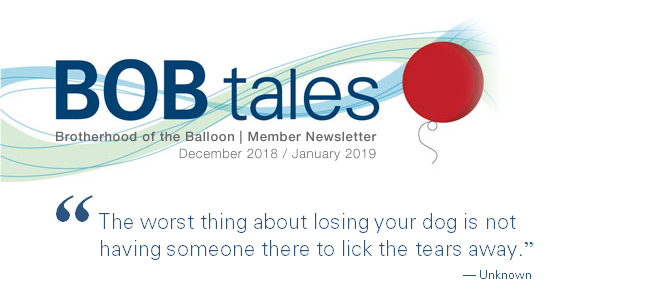
Dear Members:
My wife Pauline and I walked into a private home in New Hampshire full of anticipation. We had done our homework. April was the premier breeder of Bichon Frise dogs in the northeast and she committed to offering us the pick of the litter. All six newborns were frolicking in their pen when we arrived. One separated herself from the pack and came over to us. She was a dazzling, white fluff ball that turned inside out to be with us, licking our hands furiously to send us the message: “Pick me! Pick me!” We knew then which one we wanted.
That was a few days after the horrific attack on our country on Sept. 11, 2001. For us, the new puppy was a ray of light, a symbol of hope and goodness in a very dark time.
We named her Sadie. She instantly wormed her way into our hearts and became a huge part of our lives in many ways. She was part of everything we did. She loved boating with us, because she could have the entire family all together in a small space, each taking turns to play and cuddle with her.
One of her favorite things was to ride in a basket on the front of my bicycle. We are known all over our small town as “the guy with the white hair and the little, white puppy.” She still looked like a puppy at age 17, weighing only 10 pounds.
“Daddy” was her favorite. I don’t know what I did to deserve this, but she seemed to favor me and followed me everywhere around the house. Her favorite place to be was on my desk, in a cat bed next to the window. I built a ramp so she could go there any time she wanted. She also loved to use that perch as a lookout when Pauline and I were away for a few hours or out for the evening. When we drove into the driveway, we would see her sitting up, anxiously awaiting our return; and every time we opened the door, we received a jumping, yelping, and tail-wagging welcome that told us how much she missed and loved us.
No squirrel was safe in our back yard. Sadie loved to chase them, and then bark toward the sky after she courageously treed one.
About a year ago, Sadie’s health began to fail. Her energy declined as did her sight, hearing, and appetite. She became unsteady on her feet and was having trouble navigating the ramp to my desk. She still followed me all over the house, albeit a few steps farther behind. Her systems began to shut down over the past couple of weeks and we knew the end was near.
 We lost Sadie this month and our grief is palpable. We knew it was her time; we thought we were prepared; but we weren’t. The beautiful little snow-white fluff ball is no longer with us, but the wonderful memories remain.
We lost Sadie this month and our grief is palpable. We knew it was her time; we thought we were prepared; but we weren’t. The beautiful little snow-white fluff ball is no longer with us, but the wonderful memories remain.
Author and neurosurgeon Eben Alexander had a near-death experience from a rare illness and spent seven days in a coma. At one point, doctors thought he was dead and considered stopping treatment. During that time, Dr. Alexander says he had visions of heaven, and wrote about this in his book, Proof of Heaven. In his vision he says he saw dogs running and jumping among the people. I hope this is true. This brings Pauline and me much comfort. If any dog deserves a special place in heaven, it’s Sadie. She gave us unconditional love all day, every day, and brought everyone she met nothing but joy.
Our hearts are heavy with sadness. We miss her terribly. And we believe we will see her again someday. Sorry to bore you with her story, but it helps me to write about this beautiful and loving little dog with the huge heart and giant spirit. I also know we have many members with special dogs in their lives. Feel free to tell us about them.
This special two-month issue of BOB Tales covers a lot of ground. We have an important article on colon cancer. This topic is of great interest to me, personally, as this disease runs in my family. Both of my parents and all four of my grandparents had colon cancer, and my older sister passed away from this disease. The article focuses on important new connections being made between inflammatory diets and colon cancer. As you may know, screening colonoscopies represent an important tool in prevention and early diagnosis. Coincidentally, my next “fun” experience with this test is scheduled for this month.
One topic of great interest to many of our members is the use of testosterone supplements. We have some new information on this topic as well as an interesting finding on how a commonly prescribed medication may help prevent or slow the growth of prostate cancer.
You will learn in this issue why it’s so important for black men to discuss with their primary care physicians doing mid-life PSA screening, even if there are no prostate cancer symptoms. You may also be surprised to learn how screening guidelines for black men were developed.
Other articles this month focus on such diverse topics as a very familiar parasitic plant that can help fight prostate cancer; how genes found in urine can help detect prostate cancer; how a non-invasive test could double the odds of identifying patients who would benefit from active surveillance; more tips on avoiding the flu, including a surprising finding; and how a patient learned he has Gleason score 5+5=10 prostate cancer staging, and it was good news!
And finally, we always love discovering fun brain teasers to challenge our highly intelligent members, and interesting odds and ends that will provoke the response, “I didn’t know that!” Last month’s brain teaser was one of our toughest ever, and we have a winner. And who would have guessed which is the third-largest country in the world both in land mass and population?
We hope you enjoy this issue and, as always, we welcome your feedback.
Bob Marckini
To print the BOB Tales newsletter or view the newsletter with a larger font size, click here for the PDF file.
In this Issue:
- What You Should Know About Testosterone Supplementation
- Cholesterol Meds May Slow Prostate Cancer Growth
- Novel Liquid Biopsy for Prostate Cancer Projected to Save Millions for U.S. Health Care System
- Studies on White Men Determine Screening Guidelines for Black Men
- MRI Use Ups Odds of Active Surveillance for Prostate Cancer
- Fighting Cancer with Mistletoe?
- Using Odorant to Cure Prostate Cancer?
- New Way to Target Stubborn Prostate Cancer Cells
- Some Low-carb Diets are Associated with Higher Mortality
- Preventing Colon Cancer: Avoiding Inflammatory Diets

What You Should Know About Testosterone Supplementation
The Controversy
We receive many inquiries questioning the use of testosterone after proton treatment for prostate cancer. The use of testosterone has been a controversial subject. Some doctors suggest you should stay away from testosterone supplements completely after you’ve been treated for prostate cancer. The concern is that even for men who have been successfully treated, raising testosterone levels could potentially make dormant cancer cells start growing. Others say that after a few years, you can take testosterone supplements. But if you do, you should maintain testosterone levels in the bottom half of the normal range. It’s also recommended that when taking testosterone, you should monitor your PSA closely and stop the supplements if your PSA rises appreciably.
Age Matters
Prescription testosterone has been promoted through direct-to-consumer marketing to improve strength, endurance, mood, mental clarity, and sexual performance. However, Michael Shattuck, MD, says that while testosterone is an accepted therapy in certain conditions, it’s not considered appropriate for age-related symptoms in middle age or older men. There is lack of evidence that testosterone replacement effectively provides relief from these symptoms. Furthermore, testosterone supplements are typically prescribed for men who have symptoms and findings of deficiency, along with at least two to three fasting serum blood tests that reveal low levels of free testosterone.
Potential Side Effects
Testosterone treatment may come with some concerning side effects including prostate enlargement, abnormally increased levels of red blood cells, increased risk of developing heart disease, and worsening sleep apnea. Some have also reported excess hair growth, male pattern baldness, skin rash, acne, water retention, and nausea. And, as we stated earlier, testosterone is not known to cause prostate cancer, but some suggest it may promote the growth of prostate cancer in men with a history of the disease.
Differing Perspectives
Some researchers have reevaluated their belief that raising testosterone levels in men with a history of prostate cancer is like pouring gasoline on a fire. Several physicians have treated patients with testosterone after they’d received treatment for prostate cancer. The first to publish their experience were Drs. Joel Kaufman and James Graydon, whose article appeared in the Journal of Urology.
BOB Comment: Our opinion is that since these studies include only a small group of patients, it’s still debatable as to whether or not testosterone therapy is safe for men who have been treated for prostate cancer. It’s wise to discuss the use of testosterone with your doctor and perhaps get a second opinion before taking supplements.
Of the seven men treated by Drs. Kaufman and Graydon, with the longest followup being 12 years, none of them had a recurrence. Later, two other studies reported similar results. It’s important to note, however, the men who were treated had a low risk of recurrence to begin with. And in some cases, the duration of time the men received testosterone therapy was relatively short.
Ian Thompson, MD, chairman of the Department of Urology at the University of Texas Health Sciences Center at San Antonio, is cautious about prescribing testosterone to men who’ve been treated for aggressive prostate cancer.
“Several high-quality studies have shown that men with high-risk disease who have had external beam radiation or surgery and then take androgen deprivation therapy improve their disease-free survival. And that would suggest that testosterone supplementation would increase his risk of disease recurrence,” said Thompson. “How does that happen? Testosterone could reactivate existing disease …”
Cholesterol Meds May Slow Prostate Cancer Growth
A Finnish study found that common cholesterol medications may provide benefits for men with prostate cancer. Taking these medications over time, according to researchers, slows the growth of prostate cancer. And prostate cancer growth is slowed, regardless of how aggressive the cancer was.
Larger studies are planned to confirm these findings and to help determine whether or not cholesterol medications should be prescribed to prostate cancer patients.
Novel Liquid Biopsy for Prostate Cancer Projected to Save Millions for U.S. Health Care System
We wrote about the MDxHealth urine test in 2016.We hadn’t heard anything else about it until just recently. The test, referred to as SelectMDx, measures the amount of two genes, found in urine, that are associated with aggressive prostate cancer. The test also allows for discrimination between prostate cancer and benign conditions like prostatitis and BPH.
According to Michael K. Brawer, MD, chief medical officer at MDxHealth, SelectMDx “solves a major problem with PSA —its lack of specificity.” Brawer says men can avoid biopsies with earlier detection. SelectMDx would be used prior to an initial biopsy in men with risk factors for prostate cancer.
Studies on White Men Determine Screening Guidelines for Black Men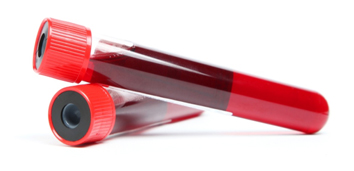
Harvard Medical School reports in a recent study, that prostate cancer screening recommendations for black men are based primarily on studies of white men.
Why is this a problem? Because black men in the U.S. are 2.5 times more likely to die
of prostate cancer compared to white men. And, researchers in this study found that PSA screening at midlife strongly predicts total and aggressive prostate cancer in black men many years into the future. But midlife screening is often frowned upon by the medical community. In fact, the U.S. Preventive Service Task Force (USPSTF) in 2012 recommended against PSA screening because, “the benefits did not outweigh the expected harms enough to recommend routine screening.” They have since loosened their guidelines somewhat, stating, “Screening for prostate cancer in men aged 55 to 69 years offers a small potential benefit of reducing the chance of death.”
The recent study led by Harvard Medical School found that a single, baseline PSA level measured during midlife strongly predicted subsequent diagnosis of total and aggressive prostate cancer up to 12 years after a blood draw. Co-lead investigator Mark Preston stated, “Our findings suggest that targeted screening based on a midlife PSA might identify black men at high risk of aggressive prostate cancer while minimizing screening in those at low risk.”
The researchers didn’t conclude that prostate biopsies or definitive treatment was necessarily required in black men with elevated baseline PSAs at midlife. But they did suggest that men in this category should undergo more intensive PSA screening to enable earlier identification of cancer and potential cure while the cancer was at an early stage.
This is one more reason for men, especially black men, to educate themselves on prostate cancer; to ensure they have excellent primary care and urological physicians; and to periodically have conversations with them about baseline and followup screening.
MRI Use Ups Odds of Active Surveillance for Prostate Cancer
We’ve written about the importance of MRI imaging in the past and feel it’s important to write about it again as it helps in the biopsy process to properly stage prostate cancer and helps patients and physicians make decisions on whether or not to treat early stage disease.
In a study of 8,144 men diagnosed with low-risk prostate cancer between 2010 and 2013, an MRI was performed on 265 patients who underwent observation compared with 230 who received treatment. After propensity score matching, those who had an MRI were associated with significant 1.9-fold greater odds of being managed with observation than undergoing definitive treatment, as reported by investigators at Yale School of Medicine.
The use of MRI imaging is associated with initial high costs, but economic modeling studies suggest that MRI would be cost-effective if it resulted in increased use of active surveillance for low-risk prostate cancer, according to lead researcher, Michael S. Leapman, MD, and his colleagues.
Fighting Cancer with Mistletoe?
More than a Christmas tradition and decoration, mistletoe—a parasitic plant that grows in trees—has been proven to be a powerful cancer fighting tool.
You may be surprised to learn that mistletoe is widely used for treating cancer in Europe and has successfully been used to treat a variety of cancers for 100 years. A fairly large amount of academic research has been done on this subject, pointing to a number of benefits including low cost, safety, and efficacy in treating a broad range of cancers including breast, gynecological, merkel cell, lymphoma, laryngeal, melanoma, glioma, squamous cell, acute myeloid leukemia, rectal, colon, abdominal, pancreatic, and even prostate cancer.
Mistletoe is a form of immunotherapy that relies heavily on the patient’s immune response. A variety of mistletoe lectins are extracted from host trees including ash, apple, oak, pine, spruce, maple, fir, birch, elm, willow, almond, poplar, hawthorn, and linden. Each extract is different and each lends itself for treatment of different cancers. The extract is used both as a stand-alone treatment and in conjunction with other treatments such as chemotherapy. Liscum, a mistletoe extract from the fir tree is produced and sold by the German pharmaceutical company, Helixor, and has been used to treat prostate cancer. A person who has read Bob’s book and is doing active surveillance has been prescribed Liscum by his M.D., an integrative doctor. We have asked him to keep us posted on his experience with Liscum.
Numerous examples of cures as well as slowing of disease progression are reported in literature. For more information read, “Mistletoe: from Christmas tradition to Cancer Fighting Tool.”
Using Odorant to Cure Prostate Cancer?
Most people, including most scientists, believe that receptors responsible for our sense of smell are only in the lining of our noses. But researchers have learned olfactory receptors are also located in the lungs, liver, skin, hear, testes, and intestines.
Why is this of interest to us? Because scientists at Duke University have determined that one olfactory receptor plays an important role in the progression of prostate cancer. And, when this receptor is activated, cancer can morph into more aggressive, castration-resistant disease.
If these researchers can find a way to block this particular receptor, it could prove to be an important step in treating prostate cancer. Lead researcher Dr. Hiroaki Matsunami is trying to identify a specific odorant that can act as a key to lock the receptor connected with prostate cancer progression. “By identifying molecules that can activate or block this receptor, we could change the course of prostate cancer,” Matsunami said.
Researchers have identified molecules that can potentially block this receptor, but much more research is needed to advance this technology to clinical trial stage.
New Way to Target Stubborn Prostate Cancer Cells
Researchers have uncovered a new compound that effectively targets stubborn prostate cancer cells that may be reistant to many common treatments. A study, published in Nature Communications, notes that this particular compound—called cyclic peptoids—specifically seeks out and targets areas that other prostate treatments can’t.

We’ve been producing BOB Tales newsletters monthly for nearly 18 years. During this time there have been important articles that many new members haven’t seen, and some long-time members may have forgotten. So, we periodically re-run articles from past newsletters. The following is from May 2013.
BOB Member Says Bob’s Book Saved His Life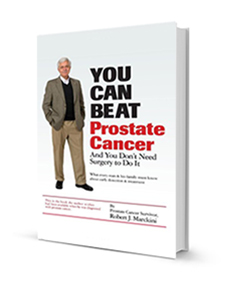
One of our members wrote to tell us an interesting story: When he had his biopsy, which involved 24 samples, he was told there was cancer in one of the samples and it was a Gleason 3+4 = 7. Because he read Bob’s book, he took our advice and had his slides read by another pathologist—one of the premier pathologists listed in the appendix of our book—Dr. Jonathan Epstein at Johns Hopkins.
What he learned shocked him and brought him some valuable information for which he was grateful. There was cancer in more than one sample and his Gleason score was not 3+4, it was 5+5 = 10!
Good News?
Why is this good news? Because the treatment that was ultimately prescribed for him was much more aggressive than it would have been had he been treated as an early-stage Gleason 3+4 patient. He is a member of our group and his PSA is 0.4.
It’s rare when the second opinion is that much different from the first, but it’s not rare for one of the premier pathology labs to differ from the initial pathology reading. We have seen many cases where a 3+3 was found to be a 3+4 or a 4+3, and we have seen cases where a 4+4 was found to be a 3+4 or a 3+3. These differences are quite significant.
In two instances, men who followed the suggestion in Bob’s book learned that there was no cancer at all in their prostates. One was scheduled for surgery. Both of these men wrote reviews of the book and posted them on Amazon.
Bottom Line
The reading of pathology slides is subjective at best. It’s not uncommon for two pathologists to report different Gleason scores when prostate cancer is diagnosed. It’s important to know the “true” score so your treatment protocol can be properly customized. Under-treating can result in a recurrence, and over-treating could result in damaging side effects.
The book, How Doctors Think, by Jerome Groopman, M.D. documents numerous cases of physician errors in testing and in interpreting test results. Dr. Groopman’s data show that as many as 15 percent of all diagnoses are inaccurate. It’s always wise to get a second or third opinion.

Thank You, Members
As you know, the BOB mission is three-fold: 1) To support each other before, during, and after treatment, 2) To promote proton therapy worldwide, and 3) To give something back, with particular emphasis on supporting proton therapy research.
You—our members—have responded generously to our repeated requests to give back over the past 18 years. Every month we see a list of contributions from members—big and small—from members recently treated and those treated 10, 15 and even 20-plus years ago. We are grateful. Every gift sends us a message that you’re listening to us, and that you care about the future of proton therapy and the many lives that will be spared and the quality of lives that will be maintained—men, women, and most important, children.
We’re proud that the Robert J. Marckini Endowed Chair is funded at $3.2 million and supports important research mentioned last month at LLUCC. Nearly half of our members have contributed a total of more than $12 million to various programs at LLUH, including members who were treated at proton centers other than LLUCC. Collectively, we’re making a huge difference.
As year-end approaches, we hope you’ll consider making a gift. Thank you.
How to Give
How to Give to Proton Therapy Research
- Donate Online: Visit the LLUCC website.
- Send a Check: Make it out to “LLUCC Proton” with “Marckini Chair” on the memo line and send to: LLUH, Office of Philanthropy, P.O. Box 2000, Loma Linda, CA 92354.
- Make a Call: Contact Regina Joseph at 909-558-5010.
How to Give to Vision 2020
- Donate online: Visit the LLUH website.
- Send a check: Make it out to: “LLUH Vision 2020.” Mail to: LLUH, Office of Philanthropy, P.O. Box 2000, Loma Linda, CA 92354.
- Make a call: Call 909-651-2020.
How to Make a Future Gift
- Make a future gift: Contact Todd Mekelburg at the Office of Planned Giving at Loma Linda University Health at 909-558-5376 or [email protected].
- Other ways to give: Contact Matt Miller at the Office of Philanthropy at Loma Linda University Health at 909-558-3582 or [email protected].

NAPT Conference 2019
The National Association for Proton Therapy (NAPT) is the voice of the proton community. The organization provides education and awareness for the public, professional, and governmental communities. Join NAPT for the 2019 National Proton Conference March 24 - 27, 2019, at The Biltmore Miami-Coral Gables in Coral Gables, FL. Attendees will include physicians, nurses, therapists, patients, proton therapy directors and managers. Learn more.

Dirty Dish Towels Can Increase Risk for Food Poisoning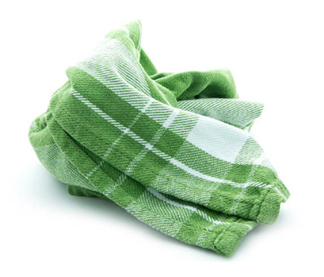
How often do you wash that towel hanging in your kitchen? Probably not enough, according to a new study.
Researchers from the University of Mauritius found that the size of your family, the food you eat, and how you use your kitchen towels impact the growth of pathogens found on the towels.
Researchers collected 100 kitchen towels after one month of use. About half contained bacterial growth, such as E. coli and staph, which increased in number with the presence of children and large family size. The towels for multipurpose use (wiping utensils, drying hands, holding hot utensils, wiping/cleaning surfaces) had a higher bacterial count than single-use towels. Moist towels had a higher bacterial count than dry ones. The presence of E. coli and staph was higher from families on non-vegetarian diets.
The presence of potential pathogens from the kitchen towels indicates that they could be responsible for cross-contamination and lead to food poisoning. “Humid towels and multipurpose use of kitchen towels should be discouraged,” says lead author on the study, Dr. Susheela D. Biranjia-Hurdoyal. “Bigger families with children and elderly members should be especially vigilant to hygiene in the kitchen.”
Some Low-carb Diets are Associated with Higher Mortality
Walter Willett, MD, professor of epidemiology and nutrition at Harvard T.H. Chan School of Public Health, conducted research on low-carbohydrate diets and found there was an important difference in life expectancy between people who ate animal-based low-carbohydrate diets vs. plant-based diets (nuts, plant oils, vegetables).
The study, reported in the Annals of Internal Medicine, concluded that “a low-carbohydrate diet based on animal sources was associated with higher all-cause mortality in both men and women, whereas a vegetable-based low-carbohydrate diet was associated with lower all-cause and cardiovascular disease mortality rates.”
New Study: The Flu Can Be Spread Simply by Breathing
People can spread the flu virus simply by breathing on you. That may not sound surprising, but the common wisdom among flu experts has been that flu wasn’t an airborne virus, spreadable only by exposure to droplets from an infected person’s cough or sneeze.
A new study found clear evidence that influenza patients breathe the virus out through their mouths and noses in tiny particles that can stay suspended in the air for minutes and even hours.
Give people plenty of space during flu season. Consider having a surgical mask on hand if you’re going to be in close quarters such as an airplane or car. And as always, heed the following tips to avoid the flu:
- Wash your hands frequently.
- Use antibacterial wipes on common surfaces frequently touched by many—such as door handles, handrails, and phones. If you’re in an office environment, clean copy machines and water dispensers.
- Avoid touching your eyes, nose, and mouth; they are all lined with mucous membranes the flu can use to get into your body.
- Use a humidifier; the flu virus thrives in dry air. Be sure to clean the humidifier regularly, as it can be a breeding ground for bacteria.
- Get the flu vaccine in September or October.
Preventing Colon Cancer: Avoiding Inflammatory Diets
Maintaining proper body weight, getting regular exercise, and eating a healthful diet are important ways to help prevent many diseases including, essentially all cancers.
A recent study, reported in the March 2018 Colon Cancer Awareness Newsletter from Digestive Digest shed some important light on colon cancer prevention. The article is titled, “Food for Thought: New Evidence Linking Dietary Patterns to Colon Cancer Risk,” by Barry Ross, MD, and Alyssa Cohen MS, RD, LDN.
The study focused on better understanding the role between inflammatory diets and colon cancer. Doctors have long believed that inflammation plays a crucial role in many illnesses, including heart disease, obesity, and cancer. Certain foods can contribute to inflammation and therefore should be reduced or eliminated from our diet.
The study followed 121,000 adults over 26 years monitoring daily eating patterns. Researchers found that processed meat, red meat, organ meat, fish (excluding dark-meat fish), some vegetables, and low-energy beverages (e.g. diet soda) were associated with increased inflammatory markers. Another study reported that people who eat five or more ounces of red meat daily are more likely to develop colon cancer. Similar studies showed that tea, apples, dark yellow vegetables (carrots, squash), cruciferous vegetables (e.g. broccoli, cauliflower) can protect the colon.
The study concluded that an anti-inflammatory diet may, indeed, be beneficial in reducing colon cancer risk. “Balance and moderation is truly the ultimate goal in nutrition, as it is in life as well,” according to the report. Not all “bad” foods need to be eliminated from your diet, but it would be wise to consume more nutrient-rich foods overall, such as fruits, vegetables and whole grains, and consume the less nutritious items only occasionally.
Six Signs You Need to Drink More Water
Thirst is the classic sign and your body’s most obvious way of letting you know it’s time for a drink, however, your breath, skin, and body temperature may also be trying to tell you you’re running low on water. Even just mild dehydration can lead to fainting, accidents, injuries and more. So how do you know when it’s time to drink up?
- Brain Fog and Exhaustion: Slight dehydration can reduce concentration, make you tired, worsen your mood, and lead to headaches.

- Hunger: Mild dehydration can mask itself as hunger and might make you crave sugar. Alternatively, staying well hydrated can trick you into feeling full.
- Bad Breath: Dry mouth from dehydration lets debris build up on mouth surfaces and contributes to foul-smelling vapors.
- Dry Skin: Dehydration can keep your skin from receiving the moisture it needs; it can lead to a dull, dusky appearance, along with stretched pores, fine lines, and flakiness.
- Headaches: Dehydration causes your blood pressure to drop—meaning less blood and oxygen is carried to the brain—which can lead to headaches
- Urine Color: If your urine is too yellow, honey-colored, or amber, it means you should drink some water. Urine should be a pale straw-yellow.
The amount of water you need during the day may vary depending on your age, health, activity level, gender, and other factors. Studies over the years have come up with conflicting recommendations because of this.
If you’re a healthy adult male living in a temperate climate, three liters of water (13 glasses) a day should keep you hydrated, according to the Institute of Medicine. For healthy adult women, 2.2 liters (nine glasses), is recommended.
Series: “Make Vegetables Taste Good”
This is the 25th segment on a subject that’s consistent with our Anticancer series. We made it our mission to find recipes that make vegetables and other healthful foods taste delicious. And, we’ve tried them all!
This recipe may be a little involved, but these may be the best enchiladas you’ll ever have. The homemade sauce is easy to make—and restaurant-quality delicious.
Vegan Butternut Squash Black Bean Enchiladas with Jalapeño Cashew Crema
Ingredients:
Cashew Crema
- ½ cup raw cashews
- 1 clove garlic
- ½ jalapeno, seeds removed (reserve the other half for topping)
- 2 tbsp. chopped cilantro
- ⅓ cup filtered water
- ¼ tsp. salt
Enchiladas
- 1 tbsp. olive oil
- 2 cloves garlic, minced
- 1 small red onion, roughly chopped
- 4 cups cubed butternut squash,
from 1 medium butternut squash - 1 tsp. chili powder
- ½ tsp. cumin
- ¼ tsp. salt
- Salt and pepper
- 1 (15 oz.) can black beans,
rinsed and drained - 12 (6-in.) corn tortillas
- To garnish:
- Fresh cilantro
- Avocado slices
- Remaining ½ of jalapeno
- Hot sauce, if desired
Enchilada Sauce
- 1 (15 oz.) can tomato sauce
- 2 tbsp. tomato paste
- 2/3 cup water (or broth of choice)
- 1/2 tsp. apple cider vinegar
- 3 cloves garlic, minced
- 2 1/2 tbsp. chili powder
- 1 1/2 tsp. cumin
- 1 tsp. dried oregano
- 1/4 tsp. cayenne pepper
1/4 tsp. salt, plus more to taste
Directions:
Preheat oven to 350 degrees F. Spray 9x13” baking pan with non-stick cooking spray.
Place ½ cup cashews in a large bowl. Add 2 cups boiling water and let the cashews soak in the water for approximately 45 minutes-1 hour while you prepare the enchiladas.
Make the sauce by adding the enchilada sauce ingredients to a large bowl: tomato sauce, tomato paste, water, apple cider vinegar, garlic, chili powder, cumin, oregano, cayenne pepper and salt. Mix well to combine.
Heat olive oil over medium heat in large skillet. Add garlic and diced onions and saute until garlic becomes fragrant (about 30 seconds). Add in cubed butternut squash, chili powder, cumin, and salt; then stir and cover for about 8 minutes or until fork tender, stirring occasionally to ensure squash doesn’t burn. Add a few teaspoons of water to the pan if necessary to help the squash cook. Once squash is fork tender, transfer to large bowl and add black beans and one cup of the prepared enchilada sauce. Stir to combine.
To assemble enchiladas: Add about 2/3 cup enchilada sauce to bottom of 9x13” pan and spread around. Wrap tortillas in wet paper towels so they are easy to roll up; warm in microwave for 20-30 seconds. Add about 1/3 cup of the butternut squash and black bean filling to each tortilla. Roll each tortilla up and place, seam side down, in baking pan. Pour remaining enchilada sauce over the top. Bake for 25-30 minutes.
While the enchiladas are baking, make the cashew crema: Add drained cashews, garlic, jalapeno, cilantro, water and salt to a high-powered blender. Blend until a thick sauce comes together, adding a tablespoon or two more of water, if necessary. Add cashew sauce to a Ziploc bag and snip off a corner. Squeeze sauce over the enchiladas.

Two Bobs and a Tom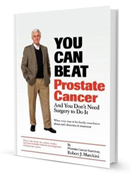
We love reading Bob Marckini’s book reviews on Amazon. We also love the fact that they’re still coming in 11 years after the book was published. That tells us the information is still valuable and that readers are passionate about sharing it with others. Clearly that passion is leading to more and more people finding their way to proton therapy.
Thank you to our latest five-star reviewers, Bob, Bob, and Tom. Excerpts from their reviews are following.

MUST READ If You Are Concerned About Prostate Cancer
A friend referred this stellar book when I was advised to get photon radiation and hormone treatment as a preventative measure for early stage prostate cancer. The advice from my docs was far premature. Upon reading this book and following up with all the resources Bob recommended, whole new vistas unfolded … Even though he is not an MD, his dedication and passion to helping men with PC is invaluable … Ask, explore, research, and take charge … —Bob V.

You need to read this book if you have prostate cancer.
Reading this book had a calming effect on my wife and me because I finally found
an alternative to the surgery my urologist was recommending. I read about the “potential” side effects that come with some methods of treatment, and I didn’t want to take that chance … I’m happy to say that I just finished treatment at the Loma Linda proton treatment center three weeks ago and my wife and I couldn’t
be happier … —Bob G.

Bob Marckini’s book helped me beat prostate cancer without surgery!
If you have been diagnosed with prostate cancer this book is a must read. It’s written in an interesting and understandable format … Many testimonials of former patients are included in the book. These enhance the legitimacy of proton treatment. As a former cancer patient who has undergone proton radiation therapy, I can wholeheartedly recommend this book. It deserves five stars! —Tom K.
We need your help.
Many medical professionals still aren’t informed about proton therapy and most mainstream media (and some doctors) discount proton therapy as a viable treatment option. We’re fighting daily for this to change. One way is through Bob’s book. Please help others find it by posting a review on Amazon and rating it from one to five stars.
Buy Bob's book online, in bulk, or in Spanish.
Online: Paperback: $19.00--•--Kindle: $7.99--•--NOOK Book: $9.99--•--Apple iBook: $9.99
In Bulk: Conctact us for a discount price list. Proceeds from book sales support proton therapy research through the Robert J. Marckini Endowed Chair at LLUCC.
In Spanish: Buy the print version or in eBook format.
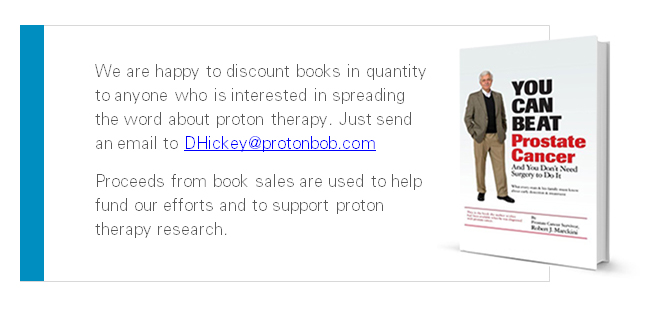

I Didn’t Know That!
- Unpaved Roads: Chances that a road is unpaved: in the U.S.A = 1 percent; in Canada = 60 percent
- Russia: The deepest hole ever drilled by man is the Kola Superdeep Borehole. It reached a depth of 12,261 meters (about 40,226 feet or 7.62 miles!) It was drilled for scientific research and gave up some unexpected discoveries, one of which was a huge deposit of hydrogen—so massive that the mud coming from the hole was boiling with it.
- Waterfalls: The water of Angel Falls (the world’s highest) in Venezuela drops 3,212 feet (979 meters.) It’s 17 times higher than Niagara Falls.
The Three Biggest Countries in the World
By Land Area:
- Russia (17.1 million square kilometers; 6.6 million square miles)
- Canada (9.98 million square kilometers; 3.85 million square miles)
- United States of America (9.63 million square kilometers; 3.71 million square miles)
By population:
- China (1.42 billion)
- India (1.35 billion)
- United States of America (327 million)
Who would have guessed that the U.S.A is third largest in both land area and population?
Estate Planning Hints
BOB Member Ron Hendricks is Director of Gift Planning for Trinity Western University. He regularly copies us on his “News from Ron” mailings, which are helpful hints on estate planning to his newsletter readers. We’ve found Ron’s suggestions to be timely and beneficial. With his permission we periodically share some of his wisdom with our membership. The following segment is called …
What does ‘Power of Attorney’ mean and why do I need one?
Power of Attorney for Healthcare
A durable power of attorney for healthcare empowers another person you select to make key decisions on your care. You may be sick and could include deciding whether an operation should be done or other major healthcare decisions should be made.
It’s important to ensure that the right person has been selected. This power of attorney can be for a period of time or durable. It’s called a “durable” power because it’s effective even if you are ill and not capable of making your own decisions; it would also continue to the end of your lifetime.
Power of Attorney for Finances
A common concern is, “What if I’m sick and no longer able to manage my property?” Unfortunately, there are far too many cases in which the property of senior persons is mismanaged or taken away by fraud or misrepresentation. A good plan to protect yourself and your property is to have a durable power of attorney for finances.
If you’re no longer able to manage your property or later wish to have someone else manage your property, this durable power of attorney will give the person you select the legal authority to buy, sell and manage your property. The durable power of attorney enables the person you designate to manage your property and provide for your care.

Last Month’s Brain Teaser
What makes this number unique?
8,549,176,320
Answer: It contains each number, zero through nine, in alphabetical order when the numbers are spelled out.
Winner: Our winner is BOB member Cliff York from Buhl, ID. Following is the message he sent us.
 I just received the November BOB Tales and was very happy and excited to get it (as always). After reading the various articles, I saw the new brain teaser and decided to send in my guess! After staring at the numbers for a while, I noticed the numerical version contains all the digits from 0 through 9 and the written version of each number is in alphabetical order. This may not be the answer you are looking for, but will send it in anyway.
I just received the November BOB Tales and was very happy and excited to get it (as always). After reading the various articles, I saw the new brain teaser and decided to send in my guess! After staring at the numbers for a while, I noticed the numerical version contains all the digits from 0 through 9 and the written version of each number is in alphabetical order. This may not be the answer you are looking for, but will send it in anyway.
Thanks for all you do—it’s greatly appreciated. I have been a member of the BOB since I was treated for prostate cancer back in 2008. At 10 years out, I’m doing great thanks to Loma Linda.
Congratulations, Cliff! Your 10-year proton anniversary gift (a signed copy of Bob’s book) is in the mail! ;)
New Brain Teaser
Two boxers are in a match scheduled for 12 rounds (pure boxing only—no kicking, UFC takedowns, or anything else). One of the boxers gets knocked out after only six rounds, yet no man throws a punch. How is this possible?
Send your answer to [email protected] for a chance to win a signed copy of Bob Marckini’s book, You Can Beat Prostate Cancer.
Bumper Stickers for Old People
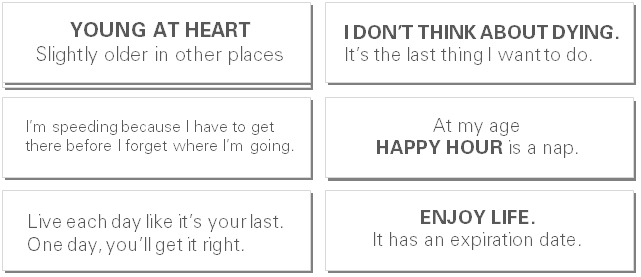
One-Liners
- I wish there was a way to donate fat like you donate blood.
- Sometimes the thoughts in my head get bored and go for a stroll out through my mouth. This is never a good thing.
- I finally reached “The Wonder Years.” Wonder where my car is parked? Wonder where I left my phone? Wonder where my sunglasses are? Wonder what day it is?
- They are not gray hairs; they are wisdom highlights. I just happen to be extremely wise.
- I don’t want to brag or make anybody jealous, but I can still fit into the earrings I wore in high school.
- Never ask Google for medical advice. I’ve gone from mild headache to clinically dead in three clicks.
- Good friends make bad days a little more bearable.
Old Age
- I didn’t make it to the gym today. That makes five years in a row.
- I decided to stop calling the bathroom the “John” and renamed it the “Jim.”
I feel so much better saying I went to the Jim this morning. - When I was a child I thought “nap time” was a punishment. Now it feels like a small vacation.
- The biggest lie I tell myself is, “I don’t need to write that down—I’ll remember it.”
- If God wanted me to touch my toes, he would’ve put them on my knees.
- Last year I joined a support group for procrastinators. We haven’t met yet.
- Of course I talk to myself; sometimes I need expert advice.
- Actually, I’m not complaining because I am a Senager (senior teenager). I have everything that I wanted as a teenager, only 60 years later. I don’t have to go to school or work. I get an allowance every month. I have my own pad. I don’t have a curfew. I have a driver’s license and my own car. And I don’t have acne. Life is great!
Quote of the Month:
“The only time my prayers are never answered is on the golf course.” —Billy Graham

The Red Marbles
It was during the waning years of the depression in a small Idaho community. I was at the corner grocery store buying some early potatoes. I noticed a small boy, delicate of bone and feature, ragged but clean, hungrily appraising a basket of freshly picked green peas. I paid for my potatoes, but was also drawn to the display of fresh green peas. I am a pushover for creamed peas and new potatoes. Pondering the peas, I couldn’t help overhearing the conversation between the store owner, Mr. Miller, and the ragged boy next to me.
“Hello Barry, how are you today?”
“H’lo, Mr. Miller. Fine, thank ya. Jus’ admirin’ them peas. They sure look good.”
“They are good, Barry. How’s your Ma?”'
“Fine … Gittin’ stronger alla’ time.”
“Good. Anything I can help you with?”
“No, Sir. Jus’ admirin’ them peas.”
“Would you like to take some home?” asked Mr. Miller.
“No, Sir. Got nuthin’ to pay for ’em with.”
“Well, what have you to trade me for some of those peas?”
“All I got’s my prize marble here.”
“Is that right? Let me see it.”
“Here ’tis … She’s a dandy.”
“I can see that. Hmm, the only thing is this one is blue and I sort of go for red. Do you have a red one like this at home?” the store owner asked.
“Not zactly, but almost.”
“Tell you what—take this sack of peas home with you and next trip this way, let me look at that red marble,” Mr. Miller told the boy.
“Sure will! Thanks Mr. Miller.”
Mrs. Miller, who had been standing nearby, came over to help me. With a smile she said, “There are two other boys like him in our community; all three are in very poor circumstances. Jim just loves to bargain with them for peas, apples, tomatoes, or whatever.”
When they come back with their red marbles, and they always do, he decides he doesn’t like red after all and he sends them home with a bag of produce for a green marble or an orange one, when they come on their next trip to the store.”
I left the store smiling to myself, impressed with this man. A short time later, I moved to Colorado, but I never forgot the story of this man, the boys, and their bartering for marbles.
Several years went by, each more rapid than the previous one. Just recently I had occasion to visit some old friends in that Idaho community and while I was there learned that Mr. Miller had died. They were having his visitation that evening and knowing my friends wanted to go, I agreed to accompany them. Upon arrival at the mortuary, we fell into line to meet the relatives of the deceased and to offer whatever words of comfort we could.
Ahead of us in line were three young men. One was in an army uniform and the other two wore nice haircuts, dark suits, and white shirts—all very professional looking. They approached Mrs. Miller, standing composed and smiling by her husband’s casket.
Each of the young men hugged her, kissed her on the cheek, spoke briefly with her, and moved on to the casket. Her misty, light blue eyes followed them as, one by one, each young man stopped briefly and placed his own warm hand over the cold pale hand in the casket. Each left the mortuary awkwardly, wiping his eyes.
Our turn came to meet Mrs. Miller. I told her who I was and reminded her of the story from those many years ago and what she had told me about her husband’s bartering for marbles. With her eyes glistening, she took my hand and led me to the casket.
“Those three young men who just left were the boys I told you about. They just told me how they appreciated the things Jim ‘traded’ them. Now, at last, when Jim couldn’t change his mind about color or size, they came to pay their debt.”
“We’ve never had a great deal of the wealth of this world,” she confided. “But right now, Jim would consider himself the richest man in Idaho.”
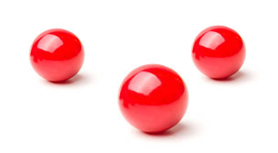 With loving gentleness she lifted the lifeless fingers of her deceased husband. Resting underneath were three exquisitely shined red marbles.
With loving gentleness she lifted the lifeless fingers of her deceased husband. Resting underneath were three exquisitely shined red marbles.
It’s not what you gather, but what you scatter that tells what kind of life you’ve lived.
We would like to wish you all a Merry Christmas, a Happy Hanukkah, and a holiday season filled with peace, joy, and good health. We hope the coming year will be overflowing with all the good things in life. And of course, low PSAs to all,
Bob Marckini and Deb Hickey
To print the BOB Tales newsletter or view the newsletter with a larger font size, click here for the PDF file.
NO MEDICAL ADVICE: Material appearing here represents opinions offered by non-medically-trained laypersons. Comments shown here should NEVER be interpreted as specific medical advice and must be used only as background information when consulting with a qualified medical professional.
